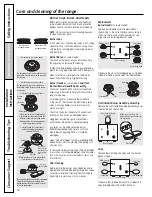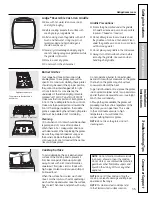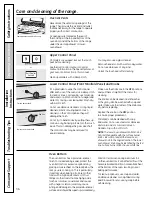
47
Installation Instructions
ELECTRICAL CONNECTIONS
Electrical Requirements
120-volt, 60 Hertz, properly grounded dedicated circuit
protected by a 15-amp or 20-amp circuit breaker or
time-delay fuse.
Extension Cord Cautions
Because of potential safety hazards associated
with certain conditions, we strongly recommend against
the use of an extension cord. However, if you still elect to
use an extension cord, it is absolutely necessary that it
be a UL-listed, 3-wire grounding-type appliance extension
cord and that the current carrying rating of the cord in
amperes be equivalent to, or greater than, the circuit
rating.
Grounding
IMPORTANT—(Please read carefully)
FOR PERSONAL SAFETY, THIS APPLIANCE MUST BE
PROPERLY GROUNDED.
The power cord of this appliance is equipped with
a 3-prong (grounding) plug which mates with a standard
3-prong grounding wall receptacle to minimize
the possibility of electric shock hazard from
this appliance.
The customer should have the wall receptacle and
circuit checked by a qualified electrician to make sure
the receptacle is properly grounded.
Where a standard 2-prong wall receptacle is
encountered, it is the personal responsibility and
obligation of the customer to have it replaced with
a properly grounded 3-prong wall receptacle.
DO NOT, UNDER ANY CIRCUMSTANCES,
CUT OR REMOVE THE THIRD (GROUND) PRONG FROM
THE POWER CORD.
A word about GFCIs – GFCIs are not required or
recommended for gas range receptacles.
Ground Fault Circuit Interrupters (GFCIs) are
devices that sense leakage of current in a circuit and
automatically switch off power when a threshold leakage
level is detected. These devices must be manually reset
by the consumer. The National Electrical Code requires
the use of GFCIs in kitchen receptacles installed to serve
countertop surfaces. Performance of the range will not
be affected if operated on a GFCI-protected circuit but
occasional nuisance tripping of the GFCI breaker is
possible.
Preferred Method
Ensure proper ground
exists before use
ELECTRICAL CONNECTIONS
(CONT.)
3
A. Usage Situations Where Appliance Power Cord Will
Be Disconnected Infrequently.
An adapter may be used only on a 15-amp circuit.
Do not use an adapter on a 20-amp circuit. Where
local codes permit, a
TEMPORARY CONNECTION
may be made to a properly grounded 2-prong wall
receptacle by the use of a UL-listed adapter, available
at most hardware stores. The larger slot in the adapter
must be aligned with the larger slot in the wall receptacle
to provide proper polarity in the
connection of the power cord.
When disconnecting the power cord from the adapter,
always hold the adapter with one hand. If this is not done,
the adapter ground terminal is very likely to break with
repeated use. Should this happen,
DO NOT USE
the
appliance until a proper ground has again been
established.
Temporary Method
Ensure proper ground
and firm connection
before use
(Adapter plugs not permitted in Canada)
Align large prongs/slots
3
CAUTION:
Attaching the adapter ground
terminal to the wall receptacle cover screw does not
ground the appliance unless the cover screw is metal,
and not insulated, and the wall receptacle is grounded
through the house wiring. The customer should have
the circuit checked by a qualified electrician to make
sure the receptacle is properly grounded.













































